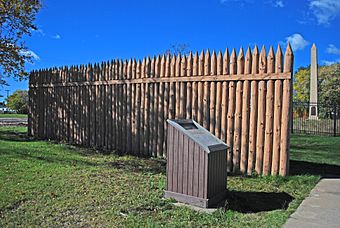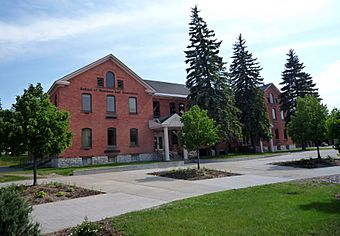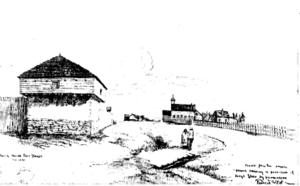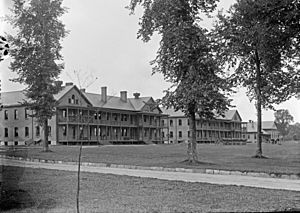Fort Brady facts for kids
|
Old Fort Brady
|
|

Reconstruction of Old Fort Brady stockade
|
|
| Location | Bounded by the C.O.E. Service Plaza on the N, Portage St. on the S, Brady St. on the E, and Bingham St. on the W, Sault Ste. Marie, Michigan |
|---|---|
| Area | 10 acres (4.0 ha) |
| Built | 1822 |
| NRHP reference No. | 71000387 |
Quick facts for kids Significant dates |
|
| Added to NRHP | March 11, 1971 |
|
New Fort Brady
|
|

Infantry barracks; now South Hall
|
|
| Location | Lake Superior State College campus, Sault Ste. Marie, Michigan |
|---|---|
| Area | 86 acres (35 ha) |
| Built | 1892 |
| NRHP reference No. | 72000605 |
| Significant dates | |
| Added to NRHP | January 13, 1972 |
Fort Brady was an important military fort built in Sault Ste. Marie, Michigan. It was created to protect American land from British forces coming from Canada. The first fort, called Old Fort Brady, was built right next to the Saint Mary's River. This fort was used from 1822 until 1893.
Later, the fort moved to a new spot on higher ground and was called New Fort Brady. It stayed there from 1893 until it closed in 1944. Both the old and new fort sites are now recognized as important historic places.
Contents
Why Fort Brady Was Built
After the War of 1812 with Britain, the United States wanted to make sure its land in the northwest was truly under American control. Even though treaties said the land belonged to the U.S., British forces sometimes crossed the border from Canada.
To stop these visits, the War Department decided to build forts along the Great Lakes. In 1820, Lewis Cass, who was the governor of Michigan Territory, made a deal with the Chippewa Nation. He arranged for the U.S. to gain control of land along the Saint Mary's River. This river connects Lake Superior and Lake Huron.
Building the First Fort
In July 1822, Colonel Hugh Brady led soldiers to Sault Ste. Marie. Their job was to show that America was in charge of the area and to build a military base. By the end of that year, Colonel Brady had built a fort on a 10-acre piece of land. It overlooked the Saint Mary's River. The soldiers at this fort helped protect the northern border of the United States.
Life at Old Fort Brady
The first Fort Brady was built with a tall fence made of cedar posts, called a stockade. There were two strong blockhouses (small forts) at opposite corners. Inside the stockade, there were log buildings for soldiers to live in and for officers' homes.
Outside the main stockade, closer to the river, were stables for horses and barns. There was also a garden, a field for the soldiers, and a cemetery. The entire fort area covered about 26 acres.
Changes Over Time
After Fort Brady was built, the British stopped crossing into American territory. Colonel Hugh Brady was promoted to general because of his success. The fort's importance decreased since there were no more battles with the British in the area.
During the Mexican–American War (1846-1848), many soldiers were sent away from Fort Brady. Michigan volunteers took their place. After that war, the fort was empty for a short time until U.S. troops returned in 1849. The army left the fort again in 1857, sending troops to Fort Snelling in Minnesota.
However, the army realized that the important shipping locks (which help boats move between different water levels) in Sault Ste. Marie needed protection. So, in 1866, soldiers came back to Fort Brady. By this time, the old buildings were falling apart. The fort was made bigger and rebuilt. Only two original buildings remained: the officer's quarters (which became a hospital) and the guardhouse (which became a bakery).
Moving to New Fort Brady
In the late 1800s, the shipping canal at Sault Ste. Marie was made wider. This meant the original spot of Fort Brady was no longer good enough. General Philip Sheridan chose a better, higher spot nearby. In 1886, work began on building a new fort. This new fort, called "New Fort Brady," was finished in 1893.
The land where the old fort stood was later divided up and sold. Today, there are no visible signs of the original fort. However, archaeologists have found parts of its old walls. A small rebuilt section of the stockade wall shows where the fort once stood.
Buildings at New Fort Brady
New Fort Brady was much larger, with 64 buildings spread across 73 acres. Fourteen of these buildings are still standing today. Many of them are now part of the Lake Superior State University campus.
- Officer's Row: These houses were built in the late 1800s or early 1900s for the fort's officers. The house where the fort's commander lived is now the home of the university president. Other officer's houses are now student dorms or university offices.
- Guardhouse: Built in the 1890s, this building was once a guardhouse and jail. It is now called East Hall and is used by the Music Department.
- Infantry Barracks: These buildings were built in 1903 for infantry soldiers to live in. One of the two original buildings was destroyed by fire. The remaining building is now South Hall and houses the College of Business and Economics.
- Post Headquarters: Built in the early 1900s, this building served as officers' housing and the fort's main office. It is now Brown Hall and is used by the Department of Education.
- Fire House: Built in the early 1900s, this building is now a Child Care Center.
- Post Office: Built in 1920, this building housed the fort's post office. It was later changed into an office building and is now the Administration Building for the university.
- East Gate: The main entrance to the fort, built in 1921, still stands. The small gatehouse now holds electrical equipment.
- WACS Barracks: This building was constructed in the 1930s for the Women's Army Corps (WACS). It is now a student residence hall called Brady Hall, named after Colonel Hugh Brady.
- Gymnasium: Built in the 1930s, this building was used for sports. It is now called the Fletcher Center and houses university offices like Student Services.
Fort Brady's Later Years
The main job of New Fort Brady was to protect the important shipping canal. Soldiers from the fort helped during local disturbances in 1894. During the Spanish–American War in 1898, about 2,000 troops passed through the fort for training.
During World War II, about 15,000 troops lived at Fort Brady. Many temporary buildings were put up to house them. The 2nd Infantry Division even trained there for cold weather to figure out what gear soldiers would need.
In 1944, before World War II ended, the army decided to close Fort Brady because it was no longer needed. In 1946, the army gave the fort to the Michigan College of Mining and Technology (now Michigan Technological University). They opened a branch campus there. Later, the fort was sold to Lake Superior State College, which is now Lake Superior State University. Many of the original buildings of New Fort Brady are still used today and form the main part of the university campus.







